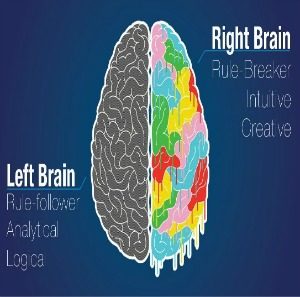
“The program director’s office is where all good ideas go to die.”
That’s a quote from a veteran major market morning host frustrated with a program director who shot down ideas immediately rather than looking for ways to make them work. That statement illustrates the clash often seen between management and talent.
Most program directors and managers are trained in the science and business of radio, yet many are not skilled at coaching, managing, and developing talent. The first step in developing star talent is learning how to communicate and collaborate with them. There is often miscommunication, or even adversarial relationships, between talent and management because managers are often left-brain/analytical types and talents are often right-brain/creative types.
Let’s look at the difference between left and right brain oriented people and see how miscommunication can happen.
We all have characteristics of both sides of the brain. We might be logically oriented and be somewhat creative or vice-versa.
If you’re an analytically oriented manager, become a student of how creative people tick and the creative process. Work on getting out of your brain and into your gut. You’ll discover that intuition and creativity are close relatives.
As a coach, your ideal role is to be a collaborator and facilitator. The essence of coaching is to help talent unlock their creative potential.
Creative talents thrive on feedback. No feedback means you’re not listening to their show, you don’t like it, or you don’t like them.
- You need to establish a relationship with talent before you can give effective feedback. Get to know them personally and creatively. To have successful collaboration, the relationship must be based on trust, and they must feel safe to take creative risks and fail.
- Once a relationship is established and nurtured, creative people will know that you are on their side and they will want to deliver.
Creative people crave feedback, yet they hate being told what to do. Begin feedback with questions. Asking questions sets up a collaborative coaching session that allows you and the talent to arrive at coaching points as a team.
- Rather than shooting ideas down immediately, explore ways to make ideas work by asking questions and guiding the process.
- For example, “How did you think the topic about parenting with callers went? Anything you’d do differently next time?”
Creative people are often insecure. If self-esteem is suppressed or diminished, then so is the person and their performance.
- Dispense feedback in a matter-of-fact tone that is solely based on performance and never personalized.
- Avoid BS comments like, “Great show!” Be specific with your feedback. “That was an excellent opening question with the guest at 7:40 this morning.”
They are vulnerable. The best talents share many of their life experiences and take emotional risks. As a coach, more than managing people, you are managing emotions. This requires active listening and empathy. As researcher Brene Brown states, “Vulnerability is the birthplace of creativity, innovation, and change.”
Creative people are childlike. Looking at the world through the eyes of a child keeps you fresh, fun, and relevant. Knowing that creative people are not looking at the world logically or reasonably will necessitate patience. Try to hear discussions from their perspective. Once you see issues from the talent’s perspective, you will have established a rapport for effective communication.
They are non-linear. Creative talents do not look at things sequentially like 1-2-3 or A-B-C. They may see situations as B-C-A or 1-3-2, for instance. It’s interesting to see that most left-brain oriented program directors create format clocks vertically down the page, and talents will draw a circle clock. Right-brain oriented people are typically visual learners and respond positively to stories and analogies.







These are all worthy and important issues, Randy, and they need to be discussed.
I do, however, take umbradge with the idea that creative folks are also chile-like – although I do appreciate the principle.
I am sure you understand that “child-like” is a temporary role that is conducive to creative thinking and is not a welded-in psychological position.
In addition, it may be useful to appreciate that audiences are processing radio – almost exclusively – through their right brain faculties.
This, then, can become a consideration of how many emotive elements are being built into our communications – with more direct concentration on the ads.
This would be be a comparison to the amount of “content” we typically provide in our commercials.
Thanks for the piece. It deserves multiple reads.